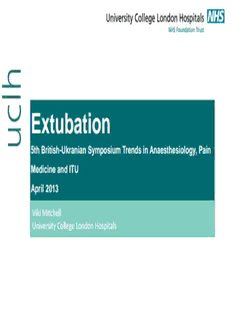
Extubation - British-Ukrainian Symposium on Anaesthesiology, IT PDF
Preview Extubation - British-Ukrainian Symposium on Anaesthesiology, IT
Extubation 5th British-Ukranian Symposium Trends in Anaesthesiology, Pain Medicine and ITU April 2013 Viki Mitchell University College London Hospitals http://das.uk.com Plan A: succeed Initial tracheal Direct laryngoscopy Tracheal intubation intubation plan failed intubation Plan B: Confirm - then Secondary tracheal succeed fibreoptic tracheal intubation plan ILMATM or LMATM intubation through ILMATM or LMATM failed oxygenation failed intubation Plan C: Maintenance of succeed oxygenation, ventilation, Revert to face mask Postpone surgery postponement of Oxygenate & ventilate Awaken patient surgery and awakening failed oxygenation Plan D: improved Rescue techniques oxygenation for "can't intubate, LMATM Awaken patient can't ventilate" situation increasing hypoxaemia or Cannula Surgical cricothyroidotomy cricothyroidotomy fail Management of the Difficult Airway: a Closed Claims Analysis ASA Guidelines 1993 1985-1992 1993-99 Induction 71% 63% Extubation 8% 14% Recovery 3% 7% Management of the Difficult Airway: a Closed Claims Analysis Peterson GN, Domino KB, Caplan RA, Posner KL, Lee LA, Cheney FW. Anesthesiology 2005:103;33-39 4 Major Complications of Airway Management NAP4 Laryngospasm POPO 10% of all cases 13/38 Airway surgery 18/38 Oedema: head down position 3/38 Obesity, asthma, COPD The executive summary highlighted: Failure to plan for failure Poor judgement Lack of training and education Difficult Airway Society guidelines for management of unanticipated difficult intubation 2004 An airway strategy should be drawn up for each patient to cover the entire period of anaesthetic care, particularly at the start and end of anaesthesia. J. J. Henderson, M. T. Popat, I. P. Latto, A. C. Pearce. Anaesthesia 59: 675–694, July 2004 A strategy , not a plan
Description: